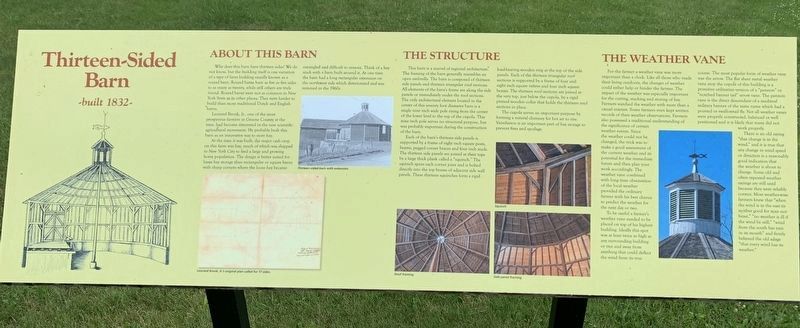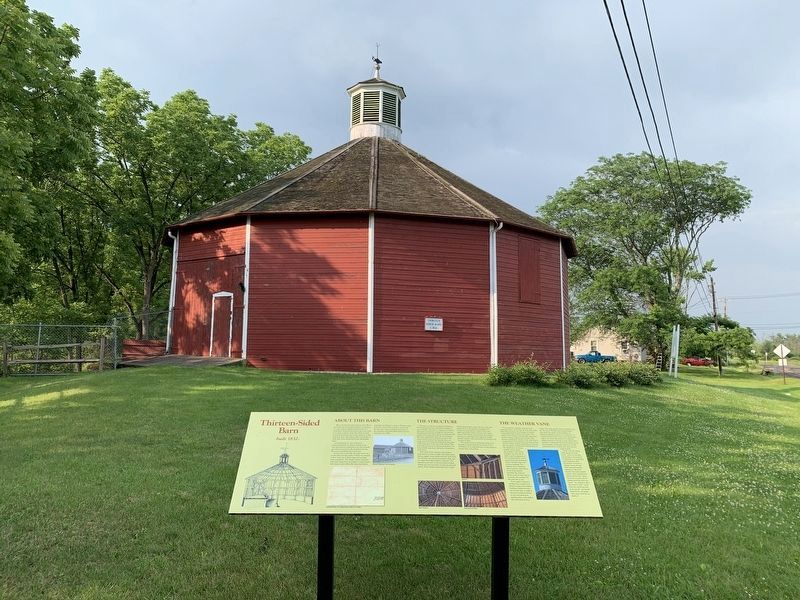Near Coxsackie in Greene County, New York — The American Northeast (Mid-Atlantic)
Thirteen Side Barn
Built 1832
About This Barn
Why does this barn have thirteen sides? We do not know, but the building itself is one variation of a type of farm building usually known as a round barn. Round barns have as few as five sides to as many as twenty, while still others are truly round. Round barns were not as common in New York as in other places. They were harder to build than more traditional Dutch and English "barns.
Leonard Bronk, Jr., one of the most prosperous farmers in Greene County at the time, had become interested in the new scientific agricultural movement. He probably built this barn as an innovative way to store hay.
At the time it was built, the major cash crop on this farm was hay, much of which was shipped to New York City to feed a large and growing horse population. The design is better suited for loose hay storage than rectangular or square barns with sharp corners where the loose hay became entangled and difficult to remove. Think of a hay stack with a barn built around it. At one time the barn had a long rectangular extension on the northwest side which deteriorated and was removed in the 1960s.
The Structure
This barn is a marvel of regional architecture. The framing of the barn generally resembles an open umbrella. The barn is composed of thirteen side panels and thirteen triangular roof sections. All elements of the barn's frame are along the side beams. The thirteen roof sections are joined at panels or immediately under the roof sections. The only architectural element located in the center of this seventy foot diameter barn is a single nine inch wide pole rising from the center of the lower level to the top of the cupola. This nine inch pole serves no structural purpose, but was probably important during the construction of the barn.
Each of the barn's thirteen side panels is supported by a frame of eight inch square posts, beams, pegged corner braces and four inch studs. The thirteen side panels are joined at their tops by a large thick plank called a "squinch.” The squinch spans each corner joint and is bolted directly into the top beams of adjacent side wall panels. These thirteen squinches form a rigid load-bearing wooden ring at the top of the side panels. Each of the thirteen triangular roof sections is supported by a frame of four and eight inch square rafters and four inch square beams. The thirteen roof sections are joined at the very top, just below the cupola, by a rigid pinned wooden collar that holds the thirteen roof sections in place.
The cupola serves an important purpose by forming a natural chimney for hot air to rise. Ventilation is an important part of hay storage to prevent fires and spoilage.
The Weather Vane
For the farmer a weather vane was more important than a clock. Like all those who made their living outdoors, the changes of weather could either help or hinder the farmer. The impact of the weather was especially important for the cutting, stacking and storing of hay. Farmers watched the weather with more than a casual interest. Some farmers even kept written records of their weather observations. Farmers also possessed a traditional understanding of the significance of certain weather events. Since the weather could not be changed, the trick was to make a good assessment of the current weather and its potential for the immediate future and then plan your work accordingly. The weather vane combined with long time observation of the local weather provided the ordinary farmer with his best chance to predict the weather for the next day or two.
To be useful a farmer's weather vane needed to be placed on top of his highest building. Ideally this spot was at least twice as high as any surrounding building or tree and away from anything that could deflect the wind from its true course. The most popular form of weather vane was the arrow. The flat sheet metal weather vane atop the cupola of this building is a primitive utilitarian version of a "pennon” or "notched banner tail” arrow vane. The pennon vane is the direct descendant of a medieval military banner of the same name which had a pointed or swallowtail fly. Not all weather vanes were properly constructed, balanced or well positioned and it is likely that many did not work properly.
There is an old saying "that change is in the wind,” and it is true that any change in wind speed or direction is a reasonably good indication that the weather is about to change. Some old and often repeated weather sayings are still used because they were reliably correct. Most weather-wise farmers knew that "when the wind is in the east tis neither good for man nor beast,” "no weather is ill if the wind be still,” "wind from the south has rain in its mouth” and firmly believed the old adage "that every wind has its weather."
Topics. This historical marker is listed in these topic lists: Agriculture • Architecture.
Location. 42° 20.764′ N, 73° 50.69′ W. Marker is near Coxsackie, New York, in Greene County. Marker is on County Route 42 near U.S. 9W, on the left when traveling north. Touch for map. Marker is in this post office area: Coxsackie NY 12051, United States of America. Touch for directions.
Other nearby markers. At least 8 other markers are within 2 miles of this marker, measured as the crow flies. Bronck House (about 400 feet away, measured in a direct line); Bronck Museum (about 400 feet away); The Bronck Farm (about 600 feet away); The Bronck Family (about 600 feet away); The Coxsackie Resolutions (about 600 feet away); In Tribute To (about 800 feet away); The Bronck Burying Ground (approx. 0.2 miles away); Reformed Low Dutch Church (approx. 1.6 miles away). Touch for a list and map of all markers in Coxsackie.
Also see . . . Bronck Farm 13-Sided Barn - National Archives. National Register of Historic Places documentation (Submitted on February 13, 2024, by Anton Schwarzmueller of Wilson, New York.)
Credits. This page was last revised on February 13, 2024. It was originally submitted on July 7, 2021, by Steve Stoessel of Niskayuna, New York. This page has been viewed 84 times since then and 10 times this year. Photos: 1, 2. submitted on July 7, 2021, by Steve Stoessel of Niskayuna, New York. • Bill Pfingsten was the editor who published this page.

